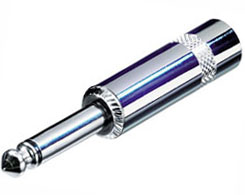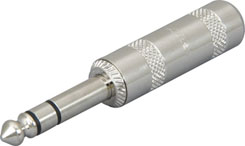Instrument Cables
Instrument Cables, true to their name, are what you use to connect the various instruments of your musical arsenal to other components of the studio.
But in addition to that, these can serve as the audio bridge between different pieces of your studio hardware.
These cables are highly versatile, carrying an analog signal via a standard 1/4" male connector plug on each end.
They are used over and over in all parts of your studio and come in 2 types: Unbalanced & Balanced.
Read on to find out the strengths and drawbacks of each type, and finally how to select the right one for your studio.
Unbalanced (TS)

This is the most basic cable we will have in the studio.
Unbalanced cables use 2 wires to transfer the signal from its source.
The 1st wire is a voltage reference known as "ground" (or "shield", or "earth").
The 2nd wire carries the signal and is known as the "hot wire".
These are also referred to as TS cables with the "T" standing for Tip (signal) and the "S" standing for Shield (ground).
Our signal is defined by comparing the "hot" wire to the "ground" wire.
As a result, noise and hum can be introduced more easily into a cable with this configuration.
This is especially true if the cable becomes very long.
Common applications for an unbalanced instrument cable are connecting a guitar to an amp or in between your sound card and mixing console.
Balanced (TRS)

Balanced cables use a 3 wire system to deliver the signal.
It has a "ground" and "hot wire" like the unbalanced cable, but adds a "cold wire" to the mix.
The 3 parts can be seen in a TRS connector.
The T, R, and S stand for Tip (hot), Ring (cold), and Sleeve (ground) respectively.
Because of this the balanced cable requires a differential or balanced input.
This 3rd wire (cold) carries an identical signal as the "hot wire", except that it is upside-down.
As a result, any noise introduced to the signal is seen in both the hot and cold wires. At the end of the cable, the cold signal is flipped back again right-side-up and any noise is canceled out.
Though this is a beautifully elegant way to solve the problem of noise being introduced into our cables... are they worth the added cost over their unbalanced counterparts.
What does the added coin get you?
The answer is easier than you might think.
Which Type Should I Use??
Why use balanced versus unbalanced cables? Reduced noise in your signal when it gets to its final destination...
Well that's the official reason at least.
In all honesty, I have balanced instrument cables in my own home studio and I cannot tell the difference.
I tested ~6' lengths, if you go longer (~50' or more) you may hear a difference.
Since we are not running 50' cables the difference in signal quality is going to be so subtle that it's unlikely you could detect it with your ears.
My advice??
Try it yourself and see if you can tell.
Most of us won't hear any difference at all... yet some will claim the difference is night and day.
These are the same bozos that can't enjoy TV anymore because the screen doesn't reproduce "greens" at just the right wavelength.
Go to any audio/video forum and see these weirdos in action if you don't believe me.
For the rest us, don't sweat it. Either way you'll probably be fine.
Ahhh! What happens if I plug my unbalanced cable into a balanced input?
The universe will explode!
Hmmmm...wait...Oh that's right. Nothing.
The balanced input will simply behave like an unbalanced input.
The only drawback is that you have 1 less balanced input at your disposal, but at least the fabric of the universe should be ok.
So now that you understand how these work you can begin to incorporate them into your studio design.









